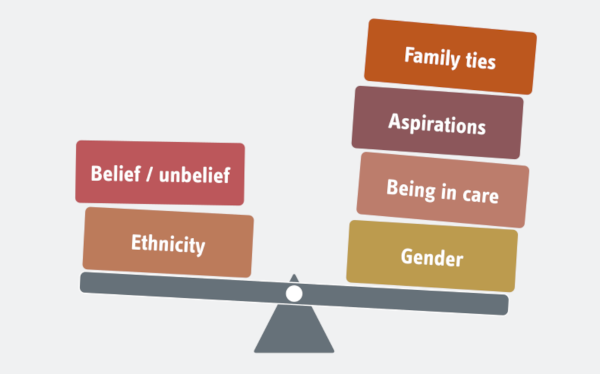Expressions of self: Supporting minoritised children’s identity, an open access Frontline Briefing, has just been published.
Researchers at Coventry University were commissioned by the Nuffield Foundation to listen to minoritised children and young people in care to understand their layered identities.
The team focused on understandings of ethnicity and religion and how these intersect with other aspects of identity.
The researchers, led by Sariya Cheruvallil-Contractor, have worked with Research in Practice to produce resources for child and family social care practitioners, based on the findings from the research. Sariya says:
We want to make a difference in the lives and care of care-experienced children and young people from minoritised ethnic groups by listening to their voices. In our most recent study, we worked with 26 young individuals of Black, Asian, and mixed descent (ages 14 to 19) to better understand their identity narratives. We focused on how ethnicity and religion influence identity and care, as well as their experiences seeking help from social workers, foster carers, and adopters. We established a new paradigm to inform both theoretical and practical work with children in care by listening to and understanding their viewpoints. Our research has resulted in a more nuanced framing of the identities of looked-after children and young people of minority ethnic and religious backgrounds.
The identity see-saw
The team developed the idea of ‘in-flux identity’ as a way of recognising that identities are layered and continually changing. This framework combines Kimberlé Crenshaw's ‘Intersectionality’ and Meredith McGuire’s ‘Lived Religion’.
They created the ‘Identity see-saw’ as a way to illustrate how identities change and evolve.

The ‘Identity see-saw'.
As well as the see-saw symbolising changes in identities, it also represents the aspects of identity that are important at a given point in time. It shows one moment in time, whilst recognising that the significance of particular aspects of identity may change based on the child or young person’s experiences, choices or particular contexts.
The see-saw's movement is largely governed by the child or young person on it, showing that individuals have agency in shaping their identity. At the same time, its movement happens within wider social contexts - including the beliefs, values and identities of the adults caring or making decisions for them.
These external and internal elements can significantly shape identity and, as these elements change, so does the young person’s identity.
This briefing and, and the tools contained within it, offer guidance on how social care practitioners can work with minoritised children and young people to explore their identities.
This podcast highlights key messages from recent research exploring the identity needs of minoritised children and young people in care. The discussion focuses on the dynamic nature of identity and how practitioners can explore what ethnicity and religion means to children and young people.
This interactive workshop will explore how care experienced children and young people, particularly from minoritised ethnic and religious backgrounds, experience and express their identities.
Facilitated by a team from Coventry University, the workshop will introduce the findings from their Nuffield Foundation funded research. They will share theory, research and also practical tools to support positive identity development for care experienced children and young people.
